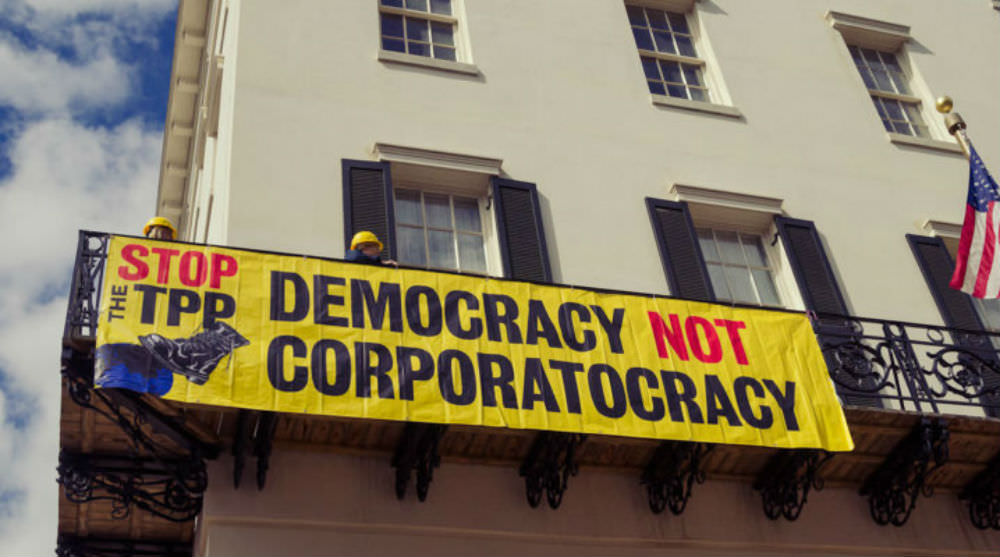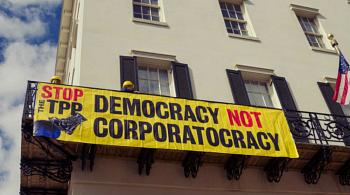Michael Geist: The Case Against Canada Ratifying The Trans Pacific Partnership Agreement
Nearly two-and-a-half months ago, I started a daily examination of the Trans Pacific Partnership focused on the intellectual property and digital policy issues raised by the agreement. My initial plan for the Trouble with the TPP series was to write for one month leading up to the planned signing in New Zealand on February 4th. However, the more I dug into the TPP, the more trouble I found. With this final post in the series, I wrap up the key IP and digital policy concerns with links to all the original posts.
Canadians interested in the TPP now have an opportunity to have their voices heard. The Standing Committee on International Trade has been conducting hearings on the agreement for several weeks and has announced plans for cross-country consultations. Canadians can provide written submissions by April 30th. Alternatively, they can ask the committee to appear as a witness. Details on the committee opportunities can be found here. In addition, Canadians can send their comments directly to Global Affairs Canada, which is managing the government’s consultation. The email address is TPP-PTP.Consultations@international.gc.ca.
Why should Canadians speak out on the TPP? The former co-CEO of Research in Motion Jim Balsillie, Shopify CEO Tobi Lutke, Ford Canada CEO Dianne Craig, the Sierra Club, Doctors Without Borders, Canadian library groups,innovation expert Dan Breznitz, former deputy chief economist at Global Affairs Canada Dan Ciuriak, Canadian publisher Don LePan of Broadview Press, political science professor Blayne Haggart, investment dispute settlement expert professor Gus Van Harten, my colleague Professor Jeremy de Beer, and the Canadian Labour Congress are among those that have voiced concern with the agreement. My assessment of the IP and digital issues in the Trouble with the TPP series identified at least 49 reasons:
Canada Was at a Negotiating Disadvantage From the Start
Canada was not an initial participant in the TPP negotiations. The price of admission into the talks was very high with the government acknowledging that it enacted U.S.-demanded copyright and anti-counterfeiting reforms as a condition of entry. Just prior to entering the negotiations, Canada agreed to further conditions, including that it could not hold up any chapter if it was the lone opponent, a position that undermined its negotiating power on many key issues. In fact, at the very late stages of negotiations, documents obtained under Access to Information reveal that the lead Canadian TPP negotiator and senior officials were warned that Canada was at a disadvantage, yet nothing was done to address the issue.
Intellectual Property Rules Lack Balance
Part of the trouble with the TPP is the remarkable lack of balance within the intellectual property chapter. For example, early drafts of the agreement that featured provisions emphasizing balance and the public domain were opposed by the U.S. and ultimately removed. The lack of balance is also evident in how new rights are treated as mandatory requirements, but user-focused provisions are typically just optional. The same is true with how the TPP addresses IP treaties: countries are required to ratify or accede to as many as nine international IP treaties, but the Marrakesh Treaty for the Visually Impaired, the only treaty concerned with user rights, is buried in a footnote and is not required. The lack of balance is also found in specific substantive provisions. For example, the border measures rules do not include the safeguards contained in Canadian law.
Copyright Costs: Term Extension, Criminal Liability and Digital Locks
The TPP copyright provisions will require significant changes to Canadian law and limit Canada’s ability to implement future reforms. The agreement will require half of the TPP countries (Canada, Japan, New Zealand, Vietnam, Malaysia and Brunei) to extend their term of copyright at a cost estimated in the hundreds of millions of dollars. The anti-circumvention rules (often referred to as digital locks) raise a host of problems: removal of flexiblity in implementing the WIPO Internet treaties, extension of criminal penalties for rights management information violations, expanding liability for circumvention for personal purposes, and precluding the ability for Canada to establish certain safeguards against digital lock restrictions as contemplated under current Canadian law. The problems with the copyright laws extend even further with the quiet expansion of criminal copyright provisions and the inclusion of U.S.-style notice-and-takedown rules that are viewed as “less speech-protective and more prone to over-enforcement and abuse.”
More IP Changes: Patents, Trademarks, Trade Secrets, and Geographical Indications
The concerns with the TPP’s intellectual property chapter extend well beyond copyright. The patent term adjustment rules will extend patent protections for some pharmaceuticals, resulting in enormous increases to health care costs. The protection for next-generation pharmaceuticals known as biologics, creates a standard of eight years of protection (five years plus three years of comparable protection) at a time when countries have adopted a wide range of approaches and even the Obama administration has sought to reduce protection to seven years. Other areas of IP are similarly controversial. Criminalization of trade secret law runs counter the established approach in most TPP countries and is the direct result of U.S. Chamber of Commerce lobbying efforts. Despite a recent overhaul of Canadian trademark law, the TPP requires further changes. The rules ongeographical indications are so complex – multiple approaches and four side letters for Canada – that businesses will struggle to make sense of the requirements. The TPP’s IP enforcement provisions also raise serious concerns with expanded border measures without court oversight, requirements that Canada provide a report card to the U.S. every six months on anti-counterfeiting activities, and the exclusion of balancing provisions on IP border measures.
Privacy At Risk
Privacy is not an issue typically associated with trade agreements, but the TPP has several provisions with privacy implications. The TPP’s general privacy provision is exceptionally weak, allowing enforceable voluntary undertakings to replace actual privacy laws. The TPP’s anti-spam provision is similarly weak, adopting an opt-out standard that many TPP countries (including Canada) have rejected as inadequate. Moreover, the TPP creates barriers to future privacy protections, with limitations on data localization requirements and data transfer restrictions. In fact, while Australia obtained a side letter from the U.S. on privacy that addresses concerns about potential privacy clashes between the U.S. and the EU, Canada did not obtain similar assurances. The TPP’ssource code rules may also pose a privacy risk as restrictions on disclosure run counter to recommendations from some of the Internet’s leading experts about how to combat exploited wifi routers.
Step Backward for the Internet and Technology
The TPP touches on the Internet and technology in many ways. In addition to the notice-and-takedown rules, it wades into the Internet governance world, potentially requiring governments to directly intervene within domestic Internet governance. The Canadian government has long rejected that approach (and urged others to do the same), but the TPP raises the possiblity of abdicating those principles in order to meet the agreement’s obligations. The TPP’s net neutrality standards fail to advance the issue with standards so weak and unenforceable that at least half of the TPP countries already exceed them. E-commerce rules do little to create more legal certainty for online transactions and the TPP’s service regulations create regulatory uncertainty for online services such as Uber and onling gambling. The TPP’s technology and telecom provisions are not much better. Limitations on source code disclosure has raised cyber-security concerns, while so-called safeguards against encryption backdoors are largely illusory and would not stop orders similar to the one involving the Apple iPhone. Canada also failed to advance its technology interests with no side agreements similar to those obtained by Australia.
Restrictions on Canadian Cultural Policy
The Canadian position on trade and culture has been consistent for decades with successive governments requiring a full exemption for the cultural industries. The TPP adopts a different approach with exceptions to the cultural exception. That includes limitations on financial contributions for Canadian content development and measures restricting access to online video content. While there is some debate on the full implications of the TPP provision, it seems certain that attempts to expand the Cancon system would be challenged under the agreement.
Health Costs and Regulation
The TPP has enormous implications for health care and access to medicines. In addition to the patent term restoration and biologics protection – which could both add millions to health care costs – the TPP places limits on medical devices and pharmaceutical data collection, provisions which are buried in the Technical Barriers to Trade chapter. The TPP also sets rules for a future national pharmacare program with provisions contained in an annex on transparency.
Risks from the Investor-State Dispute Settlement Provisions
The TPP’s investor-state dispute settlement provisions have rightly attracted considerable attention given the risks that come with a process that gives companies the right to sue governments for hundreds of millions of dollars. The TPP ISDS rules do not meet the Canadian government’s own standard for dispute settlement as reflected in the Canada – EU Trade Agreement. The CETA provisions include a clear affirmation of governmental power to regulate, an appellate process, and rules designed to ensure fairness and non-bias in settlement cases. The TPP does not contain equivalent provisions as it entrenches, rather than reforms, a flawed system. The potential costs of ISDS are huge: the Eli Lilly case highlights the impact on Canadian regulation and the prospect of hundreds of millions in liability, while Canada’s track record on investor disputes has been terrible.
Limited Economic Gains for Canada
While there are enormous costs and risks associated with the TPP, the economic studies to date suggest limited gains. Several studies project weak growth for Canada as a result of the TPP. In fact, some studies anticipate job losses for Canada with the highest per capital job losses among all TPP countries. Even sectors that are supposed winners are a mixed bag. For example, the agricultural sector may have some winners, but the dairy industry anticipates billions in losses and the wine sector says it is not ready to take advantage of the TPP.
What Comes Next
The Trouble with the TPP series examined dozens of provisions in the agreement and their implications for Canadians and Canadian law. While Canada signed the agreement last month, signing a treaty does not create binding legal obligations. As the consultation process unfolds, it is important to remember that the TPP cannot take effect unless the U.S. and Japan ratify it. Given that the TPP will require many legislative changes and create significant costs, it simply makes no sense to make those changes and incur the downside of the agreement without assurances that it will actually take effect. Ratification without assurances that the TPP will become a reality isn’t leadership. It’s stupidity. There is a very strong case against Canadian ratification of the TPP, but even if the government decides to move ahead, it must surely wait until it is certain that the deal will in fact come into force.
In fact, should Canada move toward ratification of the TPP, there is a concern that attempts to mitigate the harm of some provisions will face opposition from the U.S. While implementation flexibility is the goal of every negotiator, the U.S. reserves the right to “certify” whether other TPP countries have, in its view, properly implemented the agreement. The certification process is not found in the TPP, yet it is a part of how the U.S. approaches trade agreements that effectively grants it an additional opportunity to shape the TPP by establishing its own requirements on implementation and forcing others to abide by its interpretation of otherwise flexible provisions.
Michael Geist is the Canada Research Chair in Internet and E-commerce Law at the University of Ottawa. He can be reached at www.michaelgeist.ca.
————
This piece was originally published on Michael Geist’s blog. It’s republished here under this Creative Commons Licence.
Read More..
Comments
There are 0 comments on this post













